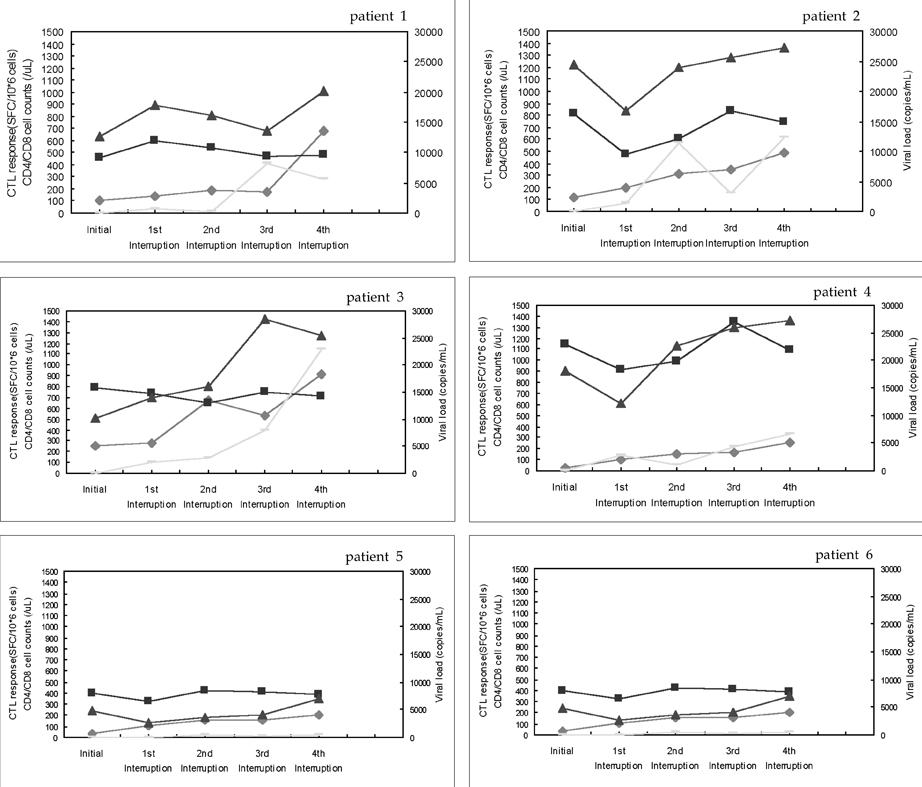Yonsei Med J.
2006 Apr;47(2):282-286. 10.3349/ymj.2006.47.2.282.
HIV-Specific Cellular Immune Responses Are Stimulated by Structured Treatment Interruption in Chronically HIV-1 Infected Koreans
- Affiliations
-
- 1AIDS Research Institute, Yonsei University College of Medicine, Seoul, Korea.
- 2Department of Internal Medicine, Yonsei University College of Medicine, Seoul, Korea. jmkim@yumc.yonsei.ac.kr
- 3Brain Korea 21 Project for Medical Sciences, Yonsei University College of Medicine, Seoul, Korea.
- KMID: 1110757
- DOI: http://doi.org/10.3349/ymj.2006.47.2.282
Abstract
- We evaluated the enhancing effect of structured treatment interruptions (STIs) on HIV-specific immunity in chronically HIV-1 infected Korean patients. A prospective case-control study was done with a total of 10 subjects for a period of 26 weeks. Six subjects were on STIs and four subjects were on continuous HAART for comparison. The STI subjects underwent four periods of STIs. For those on STIs, HAART was stopped at week 0 for two weeks, and resumed thereafter for six weeks. Viral load and CD4+/CD8+ T cells were measured by HIV RNA RT-PCR and flow cytometry, and HIV-specific immunity was measured by an ELISPOT assay. HIV-specific cytotoxic T cell immunity was more pronounced in the STI subjects than in the continuous HAART subjects after 26 weeks (p = 0.011). The difference in cytotoxic T cell response in the STI group was more prominent than in the continuous HAART group (p = 0.011). Viral load after 26 weeks was higher in the STI subjects than in the continuous HAART subjects (p = 0.008). An HIV-specific cellular immune response can be stimulated by STIs in chronically HIV-infected Koreans. A larger study is warranted in order to further characterize viral and immunological parameters of treatment with STIs in cases of chronic HIV infection.
Keyword
MeSH Terms
-
Time Factors
T-Lymphocytes, Cytotoxic/metabolism
Prospective Studies
Middle Aged
Male
Immune System
Humans
HIV Infections/*drug therapy/*immunology
Female
Drug Administration Schedule
Case-Control Studies
CD8-Positive T-Lymphocytes/metabolism
CD4-Positive T-Lymphocytes/metabolism
Anti-HIV Agents/*administration & dosage
Adult
Figure
Reference
-
1. Palella FJ Jr, Delaney KM, Moorman AC, Loveless MO, Fuhrer J, Satten GA, et al. Declining morbidity and mortality among patients with advanced human immunodeficiency virus infection. HIV Outpatient Study Investigators. N Engl J Med. 1998. 338:853–860.2. Pomerantz RJ. Reservoirs of human immunodeficiency virus type 1: the main obstacles to viral eradication. Clin Infect Dis. 2002. 34:91–97.3. Rosenberg ES, Altfeld M, Poon SH, Phillips MN, Wilkes BM, Eldridge RL, et al. Immune control of HIV-1 after early treatment of acute infection. Nature. 2000. 407:523–526.4. Lori F, Lewis MG, Xu J, Varga G, Zinn DE Jr, Crabbs C, et al. Control of SIV rebound through structured treatment interruptions during early infection. Science. 2000. 290:1591–1593.5. Ortiz GM, Wellons M, Brancato J, Vo HT, Zinn RL, Clarkson DE, et al. Structured antiretroviral treatment interruptions in chronically HIV-1-infected subjects. Proc Natl Acad Sci USA. 2001. 98:13288–13293.6. Davey RT Jr, Bhat N, Yoder C, Chun TW, Metcalf JA, Dewar R, et al. HIV-1 and T cell dynamics after interruption of highly active antiretroviral therapy (HAART) in patients with a history of sustained viral suppression. Proc Natl Acad Sci USA. 1999. 96:15109–15114.7. Youle M, Janossy G, Turnbull W, Tilling R, Loveday C, Mocroft A, et al. Changes in CD4 lymphocyte counts after interruption of therapy in patients with viral failure on protease inhibitor-containing regimens. Royal Free Centre for HIV Medicine. AIDS. 2000. 14:1717–1720.8. Sun Y, Iglesias E, Samri A, Kamkamidze G, Decoville T, Carcelain G, et al. A systematic comparison of methods to measure HIV-1 specific CD8 T cells. J Immunol Methods. 2003. 272:23–34.9. Carcelain G, Tubiana R, Samri A, Calvez V, Delaugerre C, Agut H, et al. Transient mobilization of human immunodeficiency virus (HIV)-specific CD4 T-helper cells fails to control virus rebounds during intermittent antiretroviral therapy in chronic HIV type 1 infection. J Virol. 2001. 75:234–241.10. Cardiello PG, Hassink E, Ananworanich J, Srasuebkul P, Samor T, Mahonotharit A, et al. A prospective, randomized trial of structured treatment interruption for patients with chronic HIV type 1 infection. Clin Infect Dis. 2005. 40:594–600.11. Carpenter CC, Cooper DA, Fischl MA, Gatell JM, Gazzard BG, Hammer SM, et al. Antiretroviral therapy in adults: updated recommendation of the International AIDS Society-USA panel. JAMA. 2000. 283:381–390.12. Harrigan PR, Whaley M, Montaner JS. Rate of HIV-1 RNA rebound upon stopping antiretroviral therapy. AIDS. 1999. 13:F59–F62.13. Autran B, Carcelain G, Li TS, Blanc C, Mathez D, Tubiana R, et al. Positive effects of combined antiretroviral therapy on CD4+ T cell homeostasis and function in advanced HIV disease. Science. 1997. 277:112–116.14. Plana M, Garcia F, Gallart T, Tortajada C, Soriano A, Palou E, et al. Immunological benefits of antiretroviral therapy in very early stages of asymptomatic chronic HIV-1 infection. AIDS. 2000. 14:1921–1933.
- Full Text Links
- Actions
-
Cited
- CITED
-
- Close
- Share
- Similar articles
-
- Clinical Guidelines for the Treatment and Prevention of Opportunistic Infections in HIV-infected Koreans
- Measurement of HIV-1-specific T Cell Immunity by Using Recombinant Gag Protein
- Clinical Guidelines for the Diagnosis and Treatment of HIV/AIDS in HIV-infected Koreans
- The Altered Pattern of CD28 Expression on T Cell Subsets in HIV-Infected Koreans
- Treatment and Prevention of Opportunistic Infections in HIV-Infected Patients


